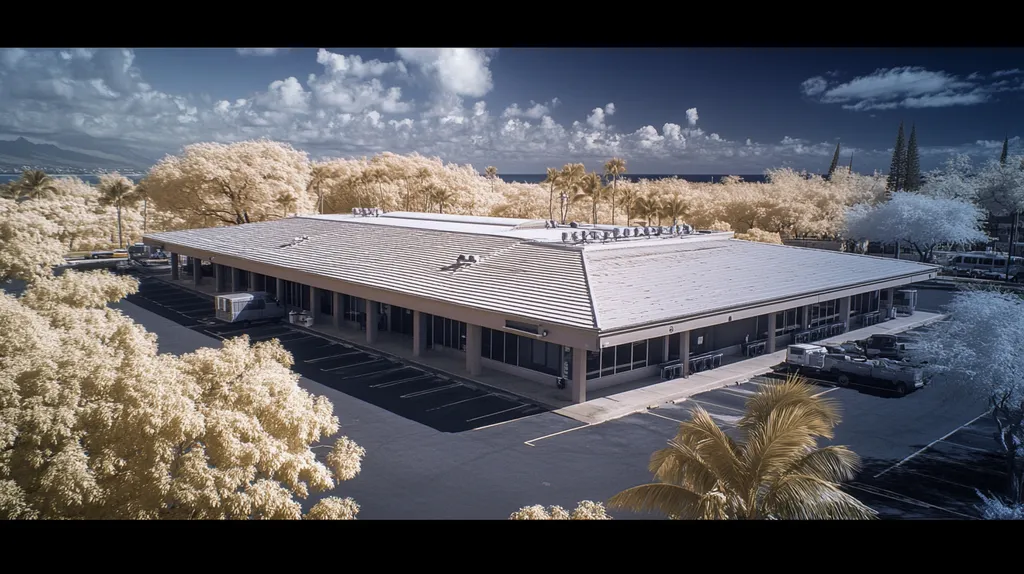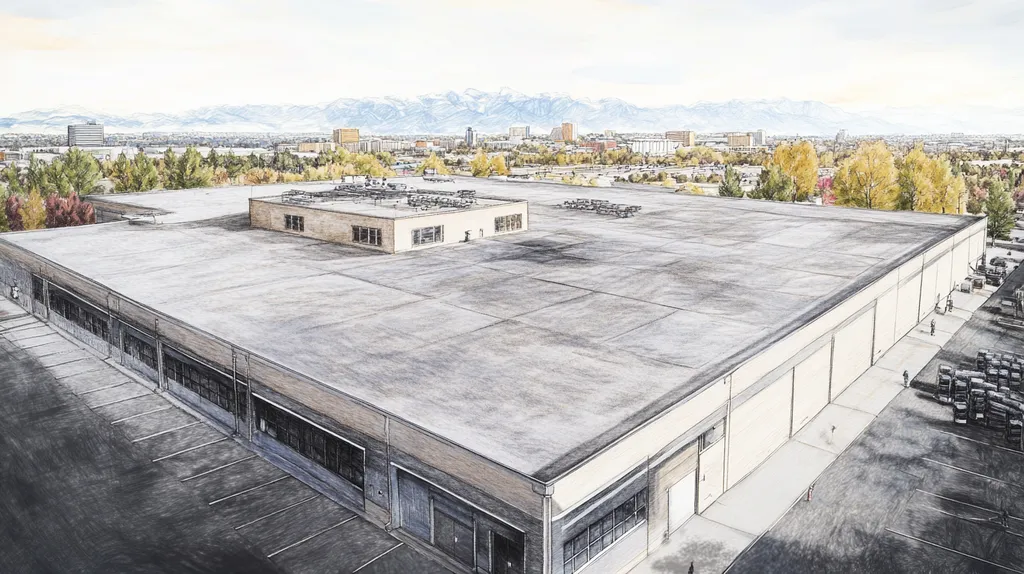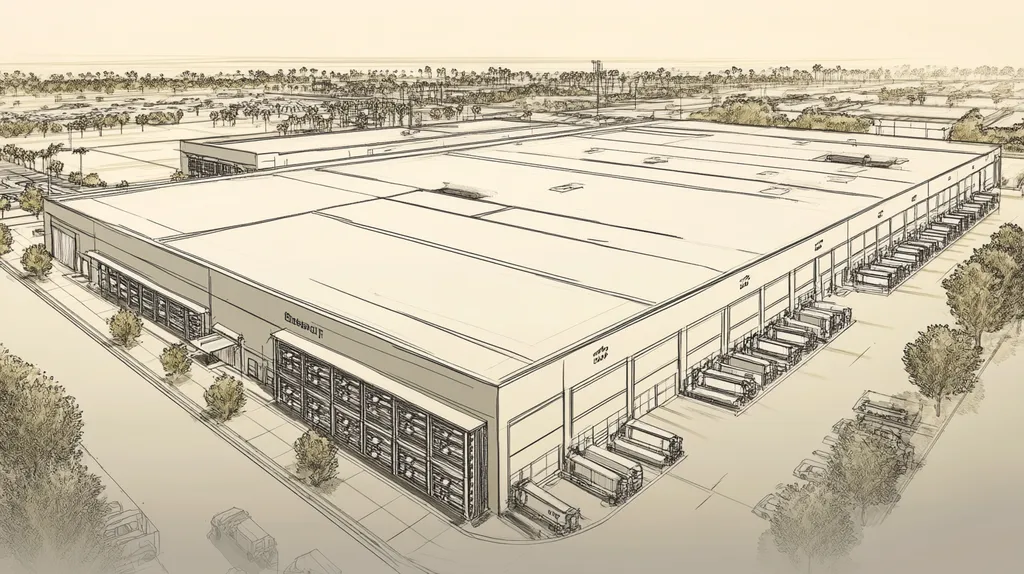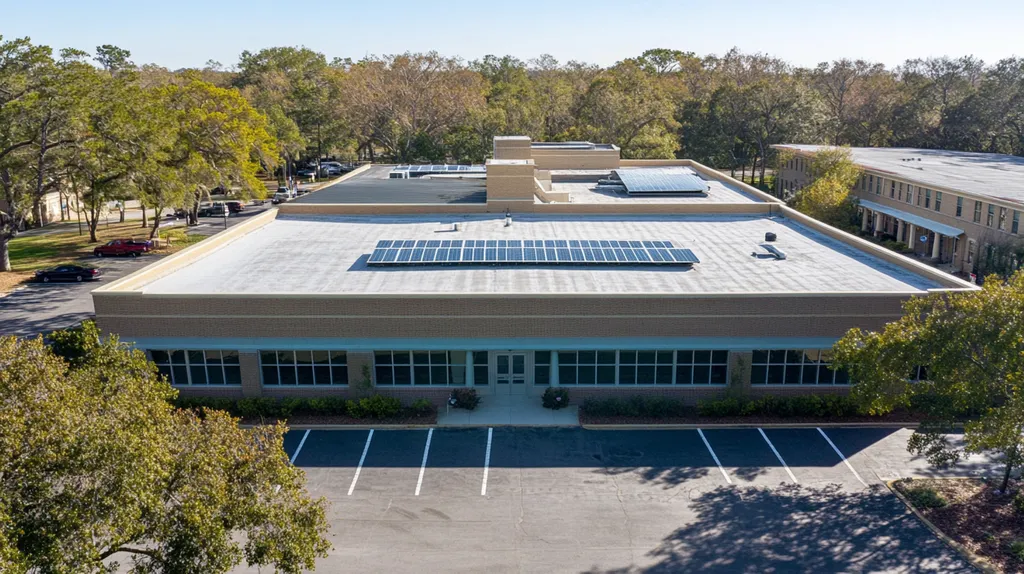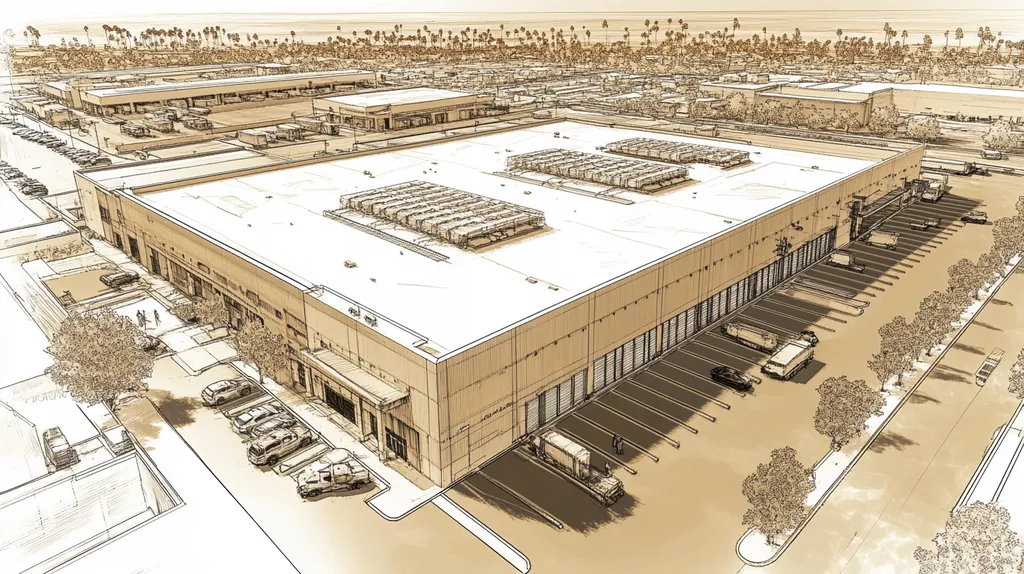Commercial property owners lose up to 40% of their buildings’ energy costs through inefficient roofing systems, translating to thousands in preventable utility expenses each year.
Modern energy-efficient roofing solutions offer a proven path to reduce these mounting costs while enhancing building performance and value.
This comprehensive guide examines the essential components of energy-efficient commercial roofing, from material selection and installation best practices to long-term maintenance strategies that maximize utility savings.
SECTION 1: THE BASICS EXPLAINED
Rising energy costs continue to strain commercial property budgets, with heating and cooling expenses often consuming up to 40% of a building’s total energy usage. The roof, as your building’s largest exposed surface, plays a crucial role in managing these costs. Modern energy-efficient roofing solutions offer property owners a proven path to significant utility savings while enhancing building performance and value.
What It Is (In Plain Language)
Energy-efficient roofing encompasses specialized materials and installation methods that work together to reduce a building’s energy consumption. These systems typically combine reflective surfaces, advanced insulation, and strategic ventilation to control heat flow.
The key components include highly reflective membranes or coatings that bounce solar radiation away from the building. These materials come in various forms, from white TPO sheets to aluminum-based coatings, all designed to minimize heat absorption.
Beneath the surface, enhanced insulation layers create a thermal barrier that maintains consistent indoor temperatures. This insulation system prevents unwanted heat transfer in both summer and winter.
Modern energy-efficient roofs also incorporate proper drainage and ventilation design to prevent moisture buildup, which can degrade insulation performance over time.
Why It Matters (To Your Building)
Energy-efficient roofing directly impacts your operational costs by reducing the workload on HVAC systems. When your roof effectively manages heat transfer, cooling systems don’t need to work as hard to maintain comfortable temperatures.
Proper operation and maintenance of energy-efficient systems can reduce energy bills by up to 20% without requiring major capital investment. This approach combines technical improvements with smart management practices to maximize savings. (source: U.S. Department of Energy)
These roofing systems also extend the life of HVAC equipment by reducing its operating hours and stress. This translates to lower maintenance costs and fewer emergency repairs.
Additionally, many utility companies and government agencies offer rebates or tax incentives for installing energy-efficient roofing, further improving your return on investment.
How It Works
Energy-efficient roofing systems function through three primary mechanisms: reflection, insulation, and ventilation. The reflective surface bounces away up to 85% of solar radiation that would otherwise be absorbed into the building.
The insulation layer acts as a thermal barrier, slowing heat transfer between the building’s interior and exterior. This barrier works year-round, keeping heat out during summer and retaining it during winter.
Strategic ventilation design allows any heat that does penetrate the system to escape rather than building up in the roofing assembly. This prevents thermal bridging and maintains insulation effectiveness.
These components work together as an integrated system, with each element supporting the others to maximize energy efficiency and reduce utility costs.
SECTION 2: PRACTICAL APPLICATIONS
Energy-efficient roofing has become essential as commercial buildings face unprecedented utility costs and stricter environmental regulations. Today’s property owners must navigate complex choices about materials, timing, and system integration to maximize their return on investment. Understanding the practical applications of energy-efficient roofing enables informed decisions that drive real cost savings while enhancing building performance.
Common Uses & Examples
Large commercial spaces like warehouses and retail centers represent prime candidates for energy-efficient roofing solutions. These buildings typically have extensive roof areas that, when properly equipped, can dramatically reduce cooling loads and utility expenses.
Manufacturing facilities benefit particularly from comprehensive roofing systems that combine reflective surfaces with enhanced insulation. These integrated solutions help maintain consistent temperatures while reducing HVAC strain in high-heat industrial environments.
A well-designed and properly installed energy-efficient roof significantly influences building energy consumption through effective temperature regulation and reduced HVAC demands. The system’s waterproofing properties further enhance performance by protecting insulation integrity. (source: Axiom D7)
Multi-tenant office buildings showcase another successful application, where energy-efficient roofing helps property managers maintain comfortable conditions while controlling operational costs. These installations often incorporate both reflective membranes and strategic insulation placement.
When You Need It Most
Properties approaching the end of their current roof’s lifespan present ideal opportunities for energy-efficient upgrades. This timing allows owners to address deteriorating conditions while implementing cost-saving improvements.
Buildings experiencing excessive utility costs or struggling with temperature control issues should prioritize energy-efficient roofing solutions. These symptoms often indicate significant energy waste through outdated or failing roof systems.
Renovation projects provide strategic opportunities to incorporate energy-efficient roofing without disrupting normal operations. Planning these upgrades during scheduled maintenance minimizes both cost and business impact.
Seasonal extremes make the benefits of energy-efficient roofing most apparent, with peak savings realized during summer cooling seasons and winter heating periods. Properties in regions with high utility rates see accelerated returns on their investment.
Interactions With Other Systems
Energy-efficient roofing works in concert with building automation systems to optimize temperature control. Modern sensors and controls can adjust ventilation and HVAC operation based on roof surface temperatures.
Solar panel installations benefit from energy-efficient roofing through improved performance and simplified mounting. The reflective properties of these roofs can enhance solar collection while maintaining structural integrity.
Drainage systems play a crucial role in maintaining roofing energy efficiency. Proper water management prevents insulation degradation and preserves the thermal properties of roofing materials.
Building envelope components like walls and windows must complement energy-efficient roofing to maximize benefits. This holistic approach ensures consistent performance across all building systems.
SECTION 3: KEY TERMINOLOGY DECODED
Commercial property owners face a bewildering array of roofing terminology that directly impacts their bottom line. Understanding these terms is crucial – misinterpreting even basic concepts can lead to choosing the wrong solutions, resulting in higher energy costs and reduced building performance. Clear comprehension of key roofing terminology enables better decision-making and helps maximize return on investment.
Essential Terms Explained
Cool roofing systems reflect more sunlight and absorb less solar energy than conventional roofs, significantly reducing building cooling loads. These specialized materials can create up to a 28°C temperature difference compared to traditional roofing on sunny days.
Beyond temperature control, cool roofs help reduce peak electricity demand while improving indoor comfort throughout the building. They also extend overall roof lifespan by minimizing thermal stress and expansion. (source: Department of Energy)
R-value measures insulation effectiveness – higher numbers indicate better thermal resistance. Commercial buildings typically require R-values between R-20 and R-40 depending on climate zone and building use.
Solar reflectance index (SRI) quantifies a material’s ability to reject solar heat. The scale runs from 0 to 100, with higher numbers indicating better heat rejection capabilities.
Industry Jargon Translated
Thermal bridging occurs when heat finds a path through building materials with lower insulation values. These bridges often develop at roof penetrations, edges, and mechanical mounting points.
Built-up roofing (BUR) refers to traditional tar-and-gravel systems created by layering waterproof materials. While durable, these systems typically offer lower energy efficiency than modern alternatives.
Single-ply membranes are large sheets of rubber or synthetic materials that create a continuous waterproof barrier. These systems often incorporate enhanced insulation and reflective properties.
Roof recovery involves installing new roofing over existing materials rather than complete removal. This approach can preserve existing insulation value while adding energy-efficient features.
Measurement & Units Simplified
Roof area calculations use “squares” as the standard unit, with one square equaling 100 square feet. This measurement helps determine material quantities and overall project scope.
Energy efficiency ratings often appear as kilowatt-hours per square foot per year (kWh/ft²/yr). Lower numbers indicate better energy performance and potential cost savings.
Surface temperature differential measures the difference between ambient air temperature and roof surface temperature. Smaller differentials indicate better thermal performance.
Payback period calculations combine installation costs with projected energy savings to determine return on investment. Most energy-efficient roofing systems achieve positive returns within 3-7 years.
SECTION 4: DECISION FACTORS
Making informed decisions about energy-efficient roofing requires careful evaluation of multiple factors that directly impact a building’s operational costs and performance. With commercial properties losing up to 40% of their energy through poor roofing choices, understanding these key decision elements becomes crucial. Property owners must weigh immediate costs against long-term savings while considering regional climate demands and building-specific requirements.
Cost Considerations
Initial investment in energy-efficient roofing typically runs 15-25% higher than traditional systems. However, these costs are offset by energy savings that can reduce cooling expenses by up to 30% annually in commercial buildings.
Available tax incentives and utility rebates can significantly reduce upfront costs. Many jurisdictions offer programs covering up to 30% of qualified energy-efficient roofing installations.
Maintenance costs generally decrease with energy-efficient systems due to their superior durability and resistance to thermal stress. This reduction in ongoing expenses contributes to faster return on investment.
Life-cycle cost analysis reveals that most energy-efficient roofing systems pay for themselves within 3-7 years through reduced utility bills and maintenance requirements.
Performance Trade-offs
A well-designed and properly installed energy-efficient roof significantly influences building energy consumption through effective temperature regulation. These systems require careful attention to waterproofing details to maintain their performance advantages over time. (source: Axiom D7)
Climate considerations play a crucial role in material selection. While white reflective membranes excel in hot climates, they may not provide optimal performance in regions with predominantly heating demands.
Building use patterns affect roofing choices. Facilities operating 24/7 benefit more from premium insulation systems, while buildings with limited occupancy may find moderate solutions more cost-effective.
Installation quality significantly impacts system performance. Superior materials installed poorly will underperform compared to standard materials installed correctly with proper attention to detail.
Lifespan & Durability Factors
Energy-efficient roofing systems typically last 20-30 years when properly maintained, compared to 15-20 years for traditional systems. This extended lifespan helps justify higher initial costs through reduced replacement frequency.
Material durability varies significantly among options. Premium single-ply membranes offer superior resistance to UV damage and thermal stress, while hybrid systems may provide better impact resistance.
Environmental exposure affects longevity considerably. Coastal locations require materials resistant to salt spray, while urban areas need systems that withstand chemical exposure and pollution.
Regular inspections and maintenance programs can extend roof life by up to 25%. This predictive approach helps prevent performance degradation while maintaining energy efficiency benefits.
SECTION 5: COMMON CHALLENGES
Energy-efficient commercial roofing systems represent significant investments that demand proper maintenance and monitoring to deliver maximum returns. Without proper attention, these high-performance systems can deteriorate rapidly, leading to increased energy costs and premature failure. Understanding common challenges, recognizing warning signs, and implementing preventative measures helps property owners protect their investment while maintaining optimal energy efficiency.
Frequent Problems & Solutions
Traditional roofing materials often absorb excessive heat, forcing cooling systems to work harder and consuming more energy. Upgrading to reflective materials and proper insulation can dramatically reduce this thermal load and associated cooling costs. (source: Lone Star Roof Systems)
Poor installation quality frequently undermines system performance, particularly around penetrations and seams. Professional installation by certified contractors, combined with proper detailing and quality materials, helps ensure optimal energy efficiency.
Moisture infiltration through compromised membranes can degrade insulation effectiveness and increase energy consumption. Regular inspections coupled with prompt repairs prevent minor issues from escalating into major problems.
Improper ventilation often leads to heat buildup and reduced system efficiency. Installing adequate ventilation systems and maintaining clear air pathways helps maintain designed performance levels.
Warning Signs To Watch For
Unexplained increases in energy bills often signal developing roofing problems. Track utility costs monthly to establish baselines and identify concerning trends early.
Visible surface deterioration, including blistering, cracking, or separation at seams, indicates potential system compromise. Address these issues promptly to prevent further damage and energy loss.
Interior signs like water stains, mold growth, or unusual odors suggest moisture penetration. These symptoms require immediate investigation to prevent insulation damage and energy waste.
Uneven temperatures across different building areas may indicate insulation failures or thermal bridging. Regular thermal imaging can help identify problem areas before they affect occupant comfort.
Preventative Approaches
Scheduled maintenance programs help identify and address issues before they impact energy efficiency. Develop comprehensive inspection schedules that include both surface examinations and subsurface evaluations.
Data-driven monitoring systems can track roof performance and energy consumption patterns. This information enables proactive maintenance decisions and validates energy savings.
Staff training ensures proper handling of rooftop equipment and early problem recognition. Regular updates keep maintenance teams current on best practices and emerging issues.
Documentation of all inspections, repairs, and modifications creates valuable historical records. These records inform maintenance planning and help optimize system performance over time.
SECTION 6: NEXT STEPS & RESOURCES
As energy costs continue to climb, commercial property owners face mounting pressure to optimize their roofing systems for maximum efficiency. With utility expenses representing up to 40% of operational costs, choosing the right energy-efficient roofing solution becomes a critical business decision. Understanding available resources, industry standards, and evaluation criteria helps owners make informed choices that deliver lasting value while reducing ongoing expenses.
Questions To Ask Providers
When evaluating roofing contractors, start by requesting detailed documentation of their energy-efficient installation experience. Ask for specific examples of similar projects and quantifiable results in terms of energy savings and ROI.
Request comprehensive explanations of their proposed materials and systems. Quality providers should clearly articulate how different components work together to enhance energy efficiency while fitting your building’s specific needs.
Metal roofs and other energy-efficient solutions may cost more initially but can reduce summer cooling costs by up to 40% while lasting over 50 years with minimal maintenance. (source: Roof Simple)
Verify that contractors maintain current certifications from major manufacturers and industry organizations. This ensures they stay updated on the latest energy-efficient technologies and installation best practices.
Discuss their quality control processes and how they verify proper installation. Ask about their protocol for testing and documenting system performance after completion.
Industry Standards & Guidelines
The ASHRAE 90.1 Energy Standard provides essential baseline requirements for commercial roofing energy efficiency. Familiarize yourself with these standards to ensure proposed solutions meet or exceed minimum requirements.
Building energy codes vary by jurisdiction but typically specify minimum R-values and solar reflectance requirements. Work with providers who demonstrate thorough knowledge of local energy codes and compliance pathways.
The Cool Roof Rating Council (CRRC) offers independent performance ratings for roofing products. Use their directory to verify manufacturer claims about energy performance and reflectivity.
ASTM International publishes key testing standards for roofing materials and assemblies. Reference these standards when reviewing product specifications and installation requirements.
The National Roofing Contractors Association provides technical guidelines and best practices for energy-efficient installations. These resources help ensure proper system design and implementation.
Further Learning Simplified
Major roofing manufacturers offer detailed technical libraries and continuing education resources. These materials help property owners understand system options and performance characteristics.
Industry publications like Professional Roofing and Buildings Magazine regularly feature case studies of successful energy-efficient installations. These real-world examples provide valuable insights into system selection and implementation.
The Department of Energy’s Building Technologies Office maintains extensive resources on commercial roofing energy efficiency. Their guidelines help owners evaluate technologies and calculate potential savings.
Local utility companies often provide energy auditing services and incentive program information. These resources can help identify opportunities for improvement while maximizing financial returns.
Professional organizations like BOMA and IFMA offer specialized training on building envelope performance. Their programs help facility managers optimize roofing system operation and maintenance.
The Bottom Line
With commercial buildings losing up to 40% of their energy costs through inefficient roofing, property owners can no longer afford to delay energy-efficient upgrades.
Modern roofing solutions combining reflective surfaces, advanced insulation, and strategic ventilation consistently deliver 20-30% reductions in annual utility expenses.
These systems typically pay for themselves within 3-7 years through reduced energy consumption and lower maintenance costs.
By understanding the key components, evaluating qualified providers, and following industry best practices, property owners can implement roofing solutions that dramatically reduce operational costs while enhancing building value.
The time to act is now – every month of delay means thousands in preventable energy waste and accelerated HVAC system wear.
FREQUENTLY ASKED QUESTIONS
Q. What is energy-efficient roofing for a commercial roof?
A. Energy-efficient roofing includes materials and methods that cut energy usage significantly. These solutions often blend reflective surfaces, advanced insulation, and ventilation to help regulate heat flow, making your building more energy efficient.
Q. How does an industrial roof benefit from energy-efficient upgrades?
A. An industrial roof can save on utility costs by maintaining stable indoor temperatures. Upgrading to energy-efficient materials reduces the strain on HVAC systems, improving their lifespan while significantly cutting heating and cooling expenses.
Q. What terms should I know about commercial roofing?
A. Key terms include R-value for insulation effectiveness and cool roofing, which reflects sunlight. Familiarizing yourself with these concepts helps make informed decisions and ensures you choose the right solutions for your commercial roof.
Q. What costs should I consider for an energy-efficient roof?
A. Initial costs for energy-efficient roofing may be higher, but the long-term savings are significant. Look for utility rebates and tax incentives to help offset these expenses. Ultimately, these roofs can lead to up to 30% savings on cooling costs annually.
Q. What common issues do energy-efficient commercial roofs face?
A. Common challenges include heat absorption and moisture infiltration. To maximize roof performance, regular inspections and maintenance of all materials and systems are essential to catch problems early and ensure energy efficiency.
Q. How can I choose the right provider for my commercial roof?
A. When selecting a provider, ask about their experience with energy-efficient roofing projects. Request examples and evidence of their installation quality. It’s also important to verify their certifications to ensure they meet industry standards.
Q. What next steps should I take for energy-efficient roofing?
A. Start by researching energy-efficient solutions suited to your building’s requirements. Consult with roofing professionals to explore options, schedule inspections, and understand the necessary maintenance for your new roofing system.

